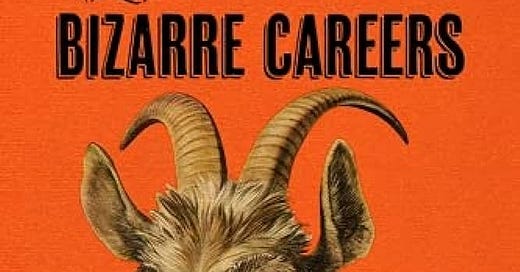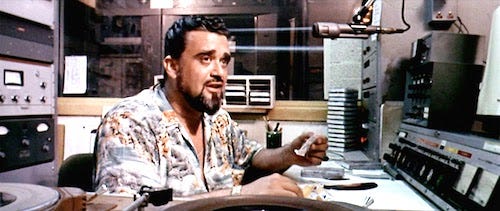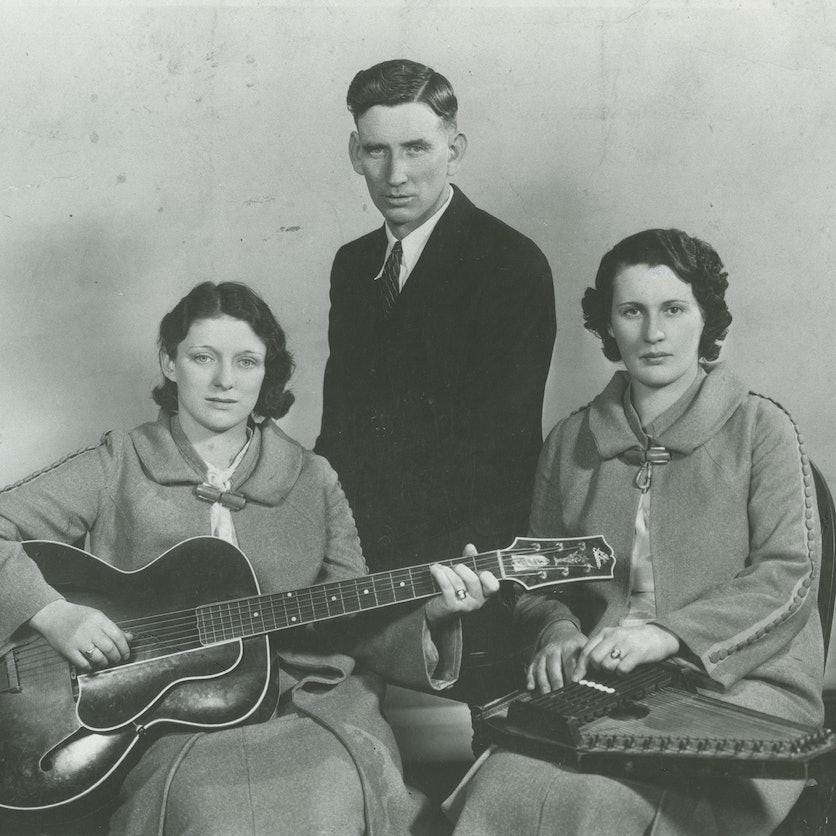Electric Medicine
The strange saga of the "goat-gland doctor" who brought country music to a mass audience
If pop culture, as Greil Marcus defined it, is “stories the market tells about itself,” this one is a doozy.
This story has a little bit of everything. It feels like it could’ve been written today, if some of the names and media were changed. At center lies an American archetype, the Confidence Man.
The con artist in question could have been lifted from the imagination of Herman Melville (The Confidence Man) or Elia Kazan (A Face in the Crowd). Bob Dylan had a bit of the confidence man in him—fibbing that he’d just blown into the East Village from New Mexico, where he’d learned a lot of “cowboy songs”—as do any number of presidential candidates past.
It’s a tale of grotesque malfeasance, country doctors, the merging of human and animal flesh, sexual desire, music, technology and politics, and the unintended positive (and negative) side effects of American quackery and capitalism. It includes a pandemic, informercials, specious treatments marketed to a hungry audience, the mass dissemination of false information, and how best to respond to it.
It gives one hope, and plenty of doubts, that things beautiful and creative can emerge from an enterprise so thoroughly corrupt.
This is “doctor” John Romulus Brinkley. He completed two-thirds of his training at an unaccredited medical school, before his education was stymied by a mountain of unpaid tuition, forcing him to turn to a diploma mill for the necessary credentials to practice surgical medicine, in some states. His specialty was implanting the glands of goat testicles into human patients—at first, into males suffering from “sexual weakness,” then as a panacea for whatever ailed anyone, regardless of sex.
He also unwittingly inspired the careers of Johnny Cash, Waylon Jennings, Chet Atkins, and Buck Owens, when they heard his country music broadcasts from border radio station XERA in Villa Acuña, Mexico—in between long-winded advertisements that constituted some of America’s first infomercials. XERA boosted the careers of Red Foley, Gene Autry, the “Father of Country Music” Jimmie Rodgers, and its “First Family,” the Carters.
XERA was the “border-blaster” so powerful (up to a million watts) that it could play music on a chainlink fence, across the border in Del Rio, Texas, where Brinkley lived. XERA transmitted country, soul, and R&B from New York to L.A. and Mexico to Canada. At times, supposedly, it could even be heard it Europe.
Brinkley, the son of a Confederate Army medic, spent most of his life itinerant, following financial opportunity, emulating in one way or another his father, who had a string of much younger wives. The niece of one spouse became J.R. Brinkley’s mother out of wedlock, while she was living with the elder Brinkley and his wife at the time, her aunt.
The younger Brinkley was schooled in a one-room log cabin. Dabbling in the communications technology of his day, he carried mail, and learned to operate a telegraph. But he always wanted to be a doctor. His father the medic died when he was ten.
His early gigs included hawking patent medicine and virility tonics as a sideman in medicine shows, impersonating a Quaker doctor, and being arrested or chased out of town for fraud and unpaid bills. At some point he determined xenotransplantation seemed like a lucrative field, and enrolled in a third-rate medical school in Chicago, before getting a fake medical degree from “Eclectic Medical University” in Kansas City. After that he opened up a storefront, “Greenville Electro Medic Doctors,” where he injected dyed water into men concerned about sexual impotence (for $800 a pop, in today’s value, marketing the placebos as syphilis antibiotics or “electric medicine from Germany.”) When he was jailed for practicing medicine without a license and writing bad checks, he laid the blame on his business partner, who ended up paying most of their settlement out of court, once Brinkley ratted him out to investigators.
In the meantime, Brinkley became a bigamist, marrying his second wife Minerva while failing to obtain a divorce from his first, another legal issue that would need to be resolved.
While working for a meat-packing concern, practicing animal medicine, Brinkley received a bit of folk wisdom. The healthiest animal slaughtered at the plant, he was told, was: the goat. By coincidence, or not, the animal also happened to be an ancient symbol of rutting fertility. The notion stuck with him.
After enlisting in the Army Reserve, being called to duty in the First World War, then discharged for a nervous breakdown after two months, he and his second wife moved to Milford, Kansas—a town in need of a doctor.
He opened an 18-room clinic in Milford, where he became popular with the locals for paying his staff well, feeding money into the local economy, and therapeutically treating victims of the 1918 flu pandemic—by most accounts, his first and only foray into actual medicine. After the pandemic, he found other revenue streams.
It was in Milford that Brinkley hit upon the idea of transplanting the tissue of goat testicles into human patients. He scored a major marketing victory with local newspapers when the wife of his first transplant patient became pregnant.
The proud parents of Brinkley’s first “goat-gland baby” named their son “Billy.”
His newfound success attracted the attention of the American Medical Association; one investigator would hound Brinkley for the rest of his life, helping deliver a dozen lawsuits for wrongful death. (By the 1930s, Brinkley had signed death certificates for over forty patients at his clinics.) Yet it would take the AMA years to catch-up with Brinkley—even as they tried to convince the Mexican government to shut his radio station down. In the meantime, the AMA determined there was little they could do beyond trying to educate the public. But they had a PR juggernaut to contend with, in Brinkley and new media.
At the invitation of Los Angeles Times owner Harry Chandler, Brinkley traveled to California to demonstrate the soundness of his treatments, with the promise that, depending on the results of the challenge, the newspaper would either make or break his reputation. Given his lack of California medical licensing, Chandler obtained a 30-day permit for “the goat-gland doctor.” When his demonstration was deemed a success, the L.A. Times delivered the promised publicity, earning him new patients, including Hollywood actors. Brinkley’s experimental transplants inspired the term “goat gland,” in the film industry—the grafting of talkie audio sequences onto silent films.
While in California, Brinkley discovered the marketing potential of radio, after touring one of Chandler’s stations. When he returned to Kansas, he resolved to open one himself, KFKB (“Kansas First, Kansas Best”), where he could hawk his wares. In-between nonstop advertising, Brinkley broadcast a veritable variety show: storytelling, French lessons, astrology, native Hawaiian music, military bands, and early American roots music—including string bands, gospel, and a nascent genre Billboard would label “Hillbilly”—later known by the euphemism concocted by Jerry Wexler, as “Country & Western.”
On KFKB, Brinkley hosted a “Medical Question Box” program. He read listener’s mail over the air, describing their ailments and prescribing treatments through a network of “Brinkley Pharmaceutical Association” pharmacies, who overcharged for worthless prescriptions while kicking-back a majority of the income to Brinkley. It made him rich.
Brinkley’s practice flourished, and “the doctor” paid some of his advertising-related income forward. He built a new post office for the town of Milford, Kansas (in part to accommodate his growing pile of business mail), financed a new sewage system, installed electricity, sidewalks, a bandstand, apartments for patients and employees, and sponsored a local baseball team, the Brinkley Goats. He was even named an honorary “admiral”—in the Kansas Navy, which feels like an appropriate distinction for a conman in a landlocked state.
When California investigators followed Brinkley to Kansas—mostly because of his questionable obtainment of a 30-day medical license from the owner of the L.A. Times—the governor of Kansas refused to extradite him. He made the state too much money. Brinkley flaunted his victory over the American Medical Association on the air.
He traveled to Europe seeking real credentials, hoping to secure an honorary medical degree abroad. Eventually, he found one at the University of Pavia, Italy—until his nemesis from the AMA, an agent named Morris Fishbein, convinced the Italian government to rescind it. The degree was revoked by none other than Benito Mussolini. Brinkley touted his nonexistent Italian credentials until his death.
Though agent Fishbein published prolific reports declaiming Brinkley’s malpractice in the Journal of the American Medical Association, these were mostly read by other doctors. Brinkley’s radio broadcasts, on the other hand, were heard by thousands every day. Soon they would reach most of the continent.
Eventually, Brinkley’s profiteering via “Medical Question Box” caught up with him. Merck & Co. complained he was mis-prescribing their pharmaceuticals on air, his radio patients began complaining to other doctors, and the Kansas Medical Board revoked his license. He lost his broadcast license as well.
He vowed to run for governor, so he could appoint the medical board of Kansas.
With KFKB country music star Roy Faulkner as his booster, Brinkley flew to campaign rallies in a chartered airplane (The Romancer) appealing to blacks and Nordic immigrants on a campaign of racial equality, education reform, public works, and lower taxes. (Later, Brinkley was rumored to be a Nazi sympathizer.) He likely would have won the governorship, if not for a last-minute issue regarding mail-in ballots—he lost thousands of votes by mail, which were disqualified.
Unable to practice medicine in Kansas or broadcast from the U.S., Brinkley sought greener pastures in Mexico. The Mexican government, looking to get back at the U.S. for dividing up North America’s airwaves without sharing, issued Brinkley a permit for a powerful broadcast antenna, which would soon increase from 150,000 watts to a million. He became the station manager at XERA, which he dubbed “the sunshine station between the nations.” XERA had the power to reach millions—especially at night, when, due to the nature of Medium Waves, its AM signal traveled farthest. Thousands, if not millions of listeners tuned in after dark.
From Mexico, Brinkley’s broadcasts could still reach Kansas, where he continued to campaign for political office over the airwaves, losing two more times. He also continued to hawk his treatments, and opened a new clinic on the border in Del Rio. He sold advertising space to a number of shills, whose wares were as dubious as Brinkley’s— “genuine simulated diamonds,” “Crazy Water Crystals,” and autographed pictures of Jesus Christ, among other religious trinkets.
Brinkley pioneered several techniques to circumvent broadcasting and advertising restrictions—one of which would be named after him. The Brinkley Act was passed to prohibit the transmission of telephone calls over the radio, after Brinkley phoned-in campaign and medical ads from Milford and Del Rio to station XERA in Mexico, where they were broadcast on air. This led him to develop the first pre-recorded radio segments on disc, to circumvent the Brinkley Act. And he inspired a new wave of “border blasters,” after the Federal Radio Commission banned “spooks”—psychics, mystics, and mind readers—on U.S. radio. Many opened stations in Mexico, one of which would broadcast Wolfman Jack in the 1950s and 60s.
Around this time, in the 1930s, Del Rio became known as “Hillbilly Hollywood,” for the string of country music stars Brinkley invited to broadcast on XERA. Most notably, the Carter Family.
Known as the “First Family of Country Music,” the Carters were a tight-knit trio from Poor Valley, Virginia—almost as tight-knit as Brinkley’s family, in which, thanks to his father’s transgressions, his mother was basically his cousin. Maybelle and Sara were cousins, married to two brothers, A.P. and Ezra “Eck” Carter. When Sara and A.P. divorced, she married her ex-husband’s cousin.
The Carters were unique in many ways, not least for having a female lead singer at the time, in Sara. Maybelle also performed vocals, and developed her own guitar technique, the “Carter scratch,” while A.P. served as a “songcatcher” and bandleader, singing backup harmonies.
In 1938 and 1939, the Carters were invited to perform on XERA for serious money, six months out of the year. They were broadcast four hours a night, with the evening broadcast repeated the following morning by “transcription disc,” a recording of the previous night’s show. It brought their music to a new generation of listeners. Johnny Cash—along with Chet Atkins, Buck Owens, and Waylon Jennings—listened to the Carters’ Good Neighbors Get Together broadcasts as a child. Later, when Maybelle and Eck brought their daughters to Del Rio to perform on XERA, Johnny Cash would hear the voice of his future wife, June Carter, for the first time.
Sara and A.P.’s marriage was disintegrating by the time they agreed to perform on Brinkley’s station, but they stuck it out for the music. Sara was already in love with A.P.’s cousin, Coy Bays, but the two lost contact after Bays drifted to the West Coast during the Great Depression. During a radio segment in February 1939, Sara dedicated a song, “I’m Thinking Tonight of My Blue Eyes” to Coy Bays, who was living in California. They married shortly afterwards, when Sara moved to California, thanks to the power of Brinkley’s antenna.
As country music—and later, through the racially-ambiguous, vaguely-rebellious voice of DJ Wolfman Jack, rock & roll—became ascendent, in part thanks to border blasters like XERA, Brinkley’s fortunes deteriorated. A competitor opened a clinic offering similar treatments in Del Rio, at much cheaper prices. When Brinkley opened a new clinic in Arkansas, his competition followed suit. In 1938, under pressure from the United States, the Mexican government revoked Brinkley’s broadcasting license, and soldiers showed up to shut XERA down. The AMA and Morris Fishbein caught up to him as well, leading to a series of trials and lawsuits, while the IRS investigated him for tax fraud, and the U.S. Postal Service for mail fraud. By this time Brinkley was suffering from numerous medical ailments himself, and underwent an operation his father might have performed on the Civil War battlefield, a leg amputation. The man who once inhabited the Brinkley Mansion in Del Rio, Texas—with its fleet of Cadillacs, water garden, swimming pool, and exotic animals imported from the Galapagos Islands—died without a cent to his name in San Antonio, in 1942.
He was interred in Forest Hill Cemetery in Memphis, Tennessee, thirty five years before Elvis Presley.
Thus did a medical grifter build a town, foster pirate radio, invigorate the music industry, spark two love affairs, and cause the deaths of numerous patients, before meeting his ignominious end.
The pop “market,” it seems, will be telling stories about this confidence man in the years to come:
"Richard Linklater and Robert Downey Jr. to Get Nuts for Dr. John Brinkley Biopic."












